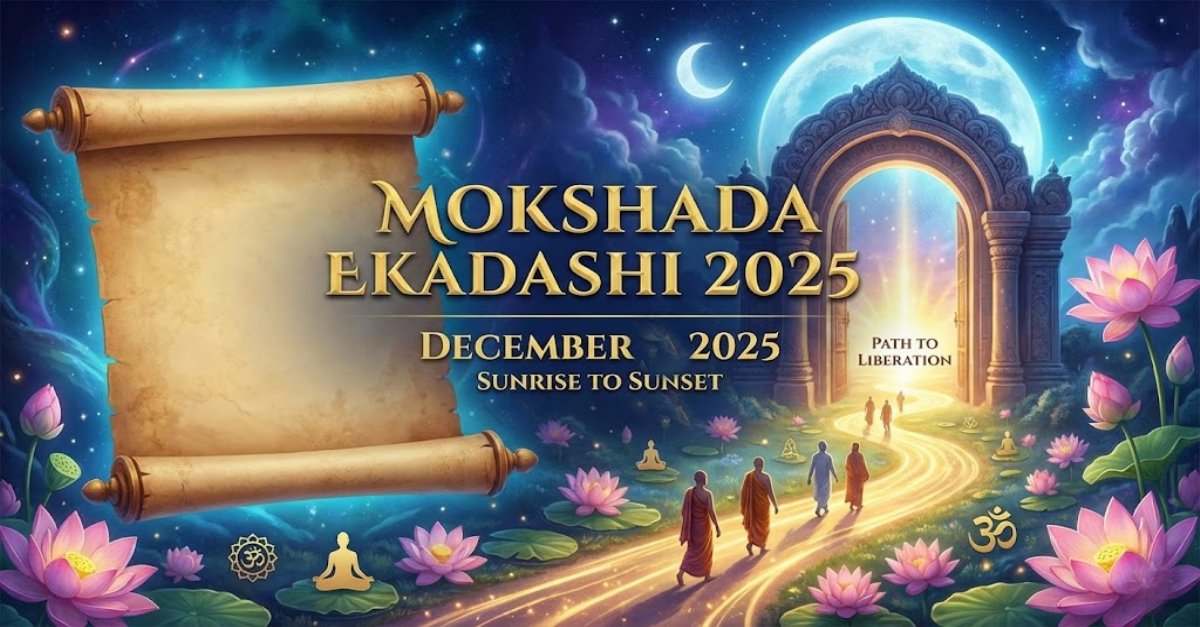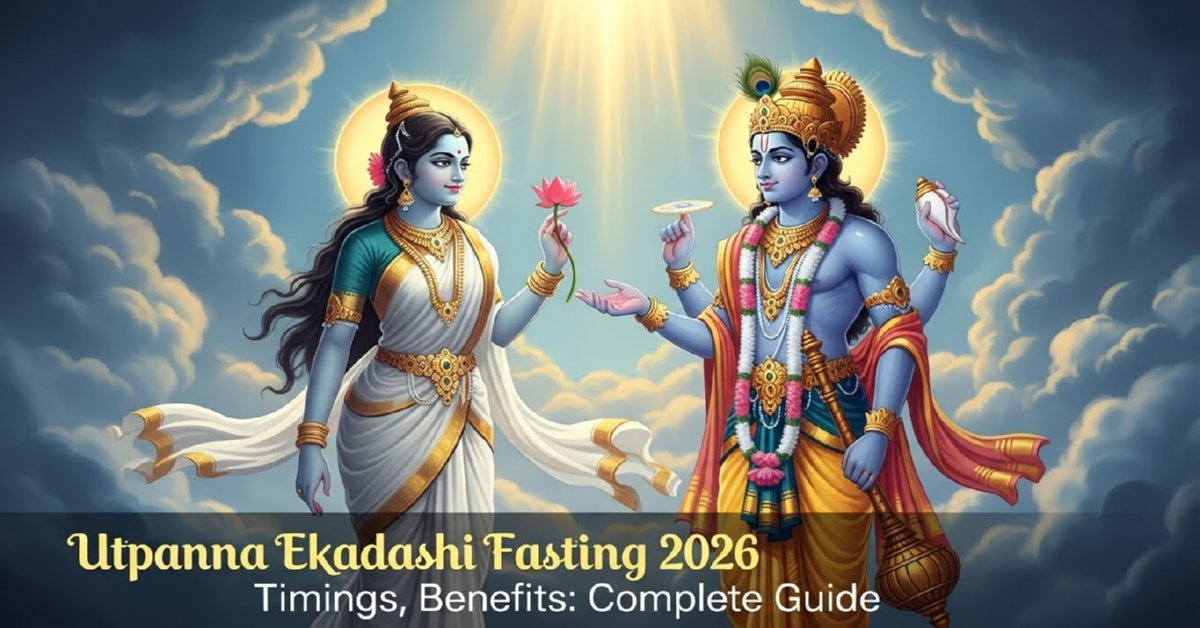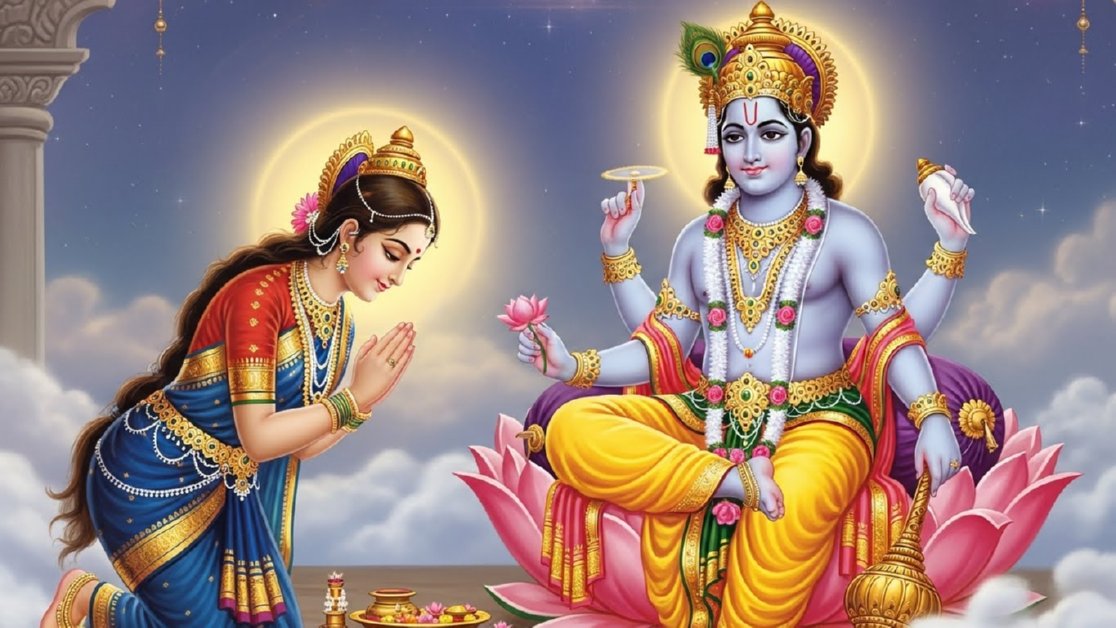According to scriptures like the Padma Purana, Lord Vishnu granted a boon stating that observing the Ekadashi fast sincerely can help devotees attain Moksha (liberation from the cycle of birth and death). The day is associated with the goddess Ekadashi Devi, who emerged from Lord Vishnu to defeat the demon Mura. The fast is thus a celebration of the triumph of divine energy over negative forces.

The word "Ekadashi" itself is sometimes interpreted as a symbol for controlling the eleven indriyas (senses): the ten organs of perception and action, plus the mind. It is believed that the lunar cycle, particularly the 11th day, has a subtle influence on the mind and body's fluids. Fasting on this day is thought to help balance these effects and increase mental clarity and focus, making it easier for meditation and spiritual contemplation.
Complete Ekadashi Calendar: Dec 2025 – Dec 2026
Mark your calendar with these scientifically aligned fasting days. Each corresponds to the optimal 120°-132° or 300°-312° lunar elongation window.
| Month | Day | Date | Ekadashi Name | Paksha | Lunar Phase (Angle) |
|---|---|---|---|---|---|
| December 2025 | Monday | December 1, 2025 | Mokshada Ekadashi | Shukla | Waxing Moon 120°-132° |
| December 2025 | Monday | December 15, 2025 | Saphala Ekadashi | Krishna | Waning Moon 300°-312° |
| December 2025 | Wednesday | December 31, 2025 | Pausha Putrada Ekadashi | Shukla | Waxing Moon 120°-132° |
| January 2026 | Wednesday | January 14, 2026 | Shattila Ekadashi | Krishna | Waning Moon 300°-312° |
| January 2026 | Thursday | January 29, 2026 | Jaya Ekadashi | Shukla | Waxing Moon 120°-132° |
| February 2026 | Friday | February 13, 2026 | Vijaya Ekadashi | Krishna | Waning Moon 300°-312° |
| February 2026 | Friday | February 27, 2026 | Amalaki Ekadashi | Shukla | Waxing Moon 120°-132° |
| March 2026 | Sunday | March 15, 2026 | Papamochani Ekadashi | Krishna | Waning Moon 300°-312° |
| March 2026 | Sunday | March 29, 2026 | Kamada Ekadashi | Shukla | Waxing Moon 120°-132° |
| April 2026 | Monday | April 13, 2026 | Varuthini Ekadashi | Krishna | Waning Moon 300°-312° |
| April 2026 | Monday | April 27, 2026 | Mohini Ekadashi | Shukla | Waxing Moon 120°-132° |
| May 2026 | Wednesday | May 13, 2026 | Apara Ekadashi | Krishna | Waning Moon 300°-312° |
| May 2026 | Wednesday | May 27, 2026 | Padmini Ekadashi | Shukla | Waxing Moon 120°-132° |
| June 2026 | Thursday | June 11, 2026 | Parama Ekadashi | Krishna | Waning Moon 300°-312° |
| June 2026 | Thursday | June 25, 2026 | Nirjala Ekadashi | Shukla | Waxing Moon 120°-132° |
| July 2026 | Friday | July 10, 2026 | Yogini Ekadashi | Krishna | Waning Moon 300°-312° |
| July 2026 | Saturday | July 25, 2026 | Devshayani Ekadashi | Shukla | Waxing Moon 120°-132° |
| August 2026 | Sunday | August 9, 2026 | Kamika Ekadashi | Krishna | Waning Moon 300°-312° |
| August 2026 | Sunday | August 23, 2026 | Shravana Putrada Ekadashi | Shukla | Waxing Moon 120°-132° |
| September 2026 | Monday | September 7, 2026 | Aja Ekadashi | Krishna | Waning Moon 300°-312° |
| September 2026 | Tuesday | September 22, 2026 | Parsva Ekadashi | Shukla | Waxing Moon 120°-132° |
| October 2026 | Tuesday | October 6, 2026 | Indira Ekadashi | Krishna | Waning Moon 300°-312° |
| October 2026 | Thursday | October 22, 2026 | Papankusha Ekadashi | Shukla | Waxing Moon 120°-132° |
| November 2026 | Thursday | November 5, 2026 | Rama Ekadashi | Krishna | Waning Moon 300°-312° |
| November 2026 | Friday | November 20, 2026 | Devutthana Ekadashi | Shukla | Waxing Moon 120°-132° |
| December 2026 | Sunday | December 6, 2026 | Utpanna Ekadashi | Krishna | Waning Moon 300°-312° |
| December 2026 | Sunday | December 20, 2026 | Mokshada Ekadashi / Vaikuntha Ekadashi | Shukla | Waxing Moon 120°-132° |
📅 Calendar Legend:
Shukla = Waxing Moon Phase (Bright Fortnight)
Krishna = Waning Moon Phase (Dark Fortnight)
120°-132° = Optimal fasting window for Shukla Paksha
300°-312° = Optimal fasting window for Krishna Paksha
The Science Behind Ekadashi: Lunar Elongation
The "Scientific" in Scientific Ekadashi refers to the precise astronomical timing. Each lunar day (Tithi) represents a 12° increase in the Moon's angular distance from the Sun.
The Optimal Fasting Window: Research suggests the most beneficial period occurs during these specific elongation ranges:
- Waxing Moon (Shukla Paksha): 120° to 132°
- Waning Moon (Krishna Paksha): 300° to 312°
During this specific lunar position, Earth experiences the lowest influence of atmospheric pressure of the lunar cycle. Fasting during this low-pressure window minimizes digestive strain while maximizing cellular repair processes like autophagy.
Vedic Traditions & Spiritual Significance
In Hindu tradition, Ekadashi is dedicated to Lord Vishnu, the preserver. The fast originates from the Padma Purana, where Ekadashi personified emerged to defeat the demon Mura.
Spiritual Benefits of Observing Ekadashi:
- Spiritual Purification: Believed to cleanse past karma and accumulate spiritual merit (Punya)
- Path to Liberation: Aids in progressing toward Moksha (spiritual liberation)
- Mental Discipline: Strengthens willpower and focuses the mind on spiritual practice
Each Ekadashi has a unique name and legend, like Vaikuntha Ekadashi, Nirjala Ekadashi (waterless fast) for ultimate penance, or Mokshada Ekadashi believed to grant liberation.
Ekadashi Fasting Rules
To maximize benefits, follow these evidence-based guidelines that align with the body's natural rhythms during low lunar pressure periods.
🚫 Foods to AVOID (Grains & Heavy Substances):
- All grains: Rice, wheat, oats, corn, etc.
- Pulses & legumes: Lentils, beans, chickpeas
- Specific spices: Asafoetida, turmeric, mustard seeds
- Regular salt: Use rock salt (Sendha Namak) instead
- Honey (in some traditions)
✅ Foods PERMITTED (Sattvic/Nourishing):
- Fruits & vegetables: All fruits, potatoes, sweet potatoes, bottle gourd
- Nuts & seeds: Almonds, cashews, walnuts, raisins
- Dairy: Milk, yogurt, paneer (in moderation)
- Fasting flours: Buckwheat (Kuttu), water chestnut (Singhara), tapioca (Sabudana)
Breaking the Fast (Parana): Break your fast on Dwadashi (the 12th lunar day) during the prescribed morning window. Traditional breaking foods like amla (Indian gooseberry) offer additional cleansing benefits.
Holistic Health Benefits of Lunar-Aligned Fasting
Fasting during the optimal lunar elongation window provides synergistic benefits for body, mind, and spirit:
- Autophagy Activation: Triggers cellular self-cleaning (2016 Nobel Prize in Physiology/Medicine recognized autophagy research)
- Digestive System Reset: Gives your GI tract a complete rest, improving gut health and efficiency
- Mental Clarity Boost: Redirects energy from digestion to cognitive functions, enhancing focus and awareness
- Lunar Rhythm Synchronization: Aligns your body's cycles with natural gravitational patterns
- Metabolic Flexibility: Trains your body to efficiently switch between fuel sources (carbs to fats)
Frequently Asked Questions
Q: What's the difference between "Traditional" and "Scientific" Ekadashi?
A: The date is generally the same. The "scientific" designation emphasizes the precise 120°-132° elongation window when fasting is most effective. Traditional calendars use sunrise calculations, which sometimes shift the observance by a day.
Q: Why the 300°–312° range for waning moon?
A: The lunar cycle is 360°. The waning phase equivalent to the waxing 120°–132° window is 300°–312° (360° - 60°). This maintains the same 5-tithi distance from the New Moon as the waxing phase has from the Full Moon.
Q: Who should avoid strict Ekadashi fasting?
A: Pregnant/nursing women, children, elderly individuals, and those with medical conditions (diabetes, hypotension, kidney issues) should consult a doctor. They can observe a modified fast with permitted foods instead.
Q: Can I drink water during Ekadashi fast?
A: Yes, unless you're observing Nirjala Ekadashi (the waterless fast). Hydration is generally encouraged. Herbal teas and coconut water are also permissible in most traditions.







